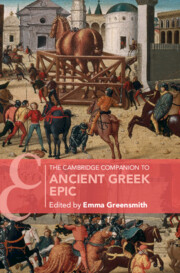Book contents
- The Cambridge Companion to Ancient Greek Epic
- The Cambridge Companion to Ancient Greek Epic
- Copyright page
- Contents
- Figures
- Contributors
- Preface
- Introduction
- Part I Epic Engagements
- Part II Epic Space
- 4 Space and Story
- 5 Do Not Talk Death to Me
- 6 Epic Dislocation
- 7 Shrunken Epic
- Part III Epic Time
- Part IV Epic People
- Part V Epic Feelings
- Part VI Epic Without End
- Epilogue
- Timeline of Ancient Greek Epic
- Bibliography
- Index Locorum
- Subject Index
- Cambridge Companions To Literature
7 - Shrunken Epic
The Poetics of Epyllion
from Part II - Epic Space
Published online by Cambridge University Press: 04 December 2024
- The Cambridge Companion to Ancient Greek Epic
- The Cambridge Companion to Ancient Greek Epic
- Copyright page
- Contents
- Figures
- Contributors
- Preface
- Introduction
- Part I Epic Engagements
- Part II Epic Space
- 4 Space and Story
- 5 Do Not Talk Death to Me
- 6 Epic Dislocation
- 7 Shrunken Epic
- Part III Epic Time
- Part IV Epic People
- Part V Epic Feelings
- Part VI Epic Without End
- Epilogue
- Timeline of Ancient Greek Epic
- Bibliography
- Index Locorum
- Subject Index
- Cambridge Companions To Literature
Summary
This chapter is centred on the controversial epic ‘sub’ genre of the epyllion. Verhelst first underlines the scholarly debates surrounding epyllion as a category and then turns to look more closely at poems which themselves could be termed ‘epyllionic’, starting with the Homeric Hymn to Hermes, and moving through the Hellenistic age (Theocritus’ Idyll 24, Moschus’ Eros the Runaway, and the Batrachomyomachia) to late antiquity (the Orphic Argonautica and Colluthus’ Abduction of Helen). Verhelst focuses not just on the aesthetic dimensions of these poems, but also on the characters contained within them: ‘small’ characters in small epic (children, Hermes, eros, frogs and mice) and foreboding cameos by ‘large’ figures like Achilles. Verhelst shows how these texts manipulate their mythological, primarily Homeric, models to put grand epic heroics into a new perspective, be it comical or dark, and suggests how characterisation, size and speed are key ways to understand how these poems negotiate their own position in relation to Homer and the epic tradition, as ‘shrunken’, but not diminutive epic.
Keywords
- Type
- Chapter
- Information
- The Cambridge Companion to Ancient Greek Epic , pp. 147 - 166Publisher: Cambridge University PressPrint publication year: 2024

